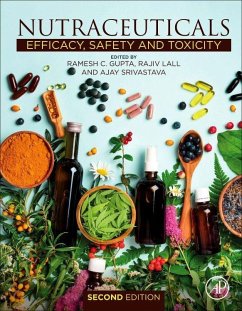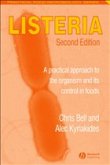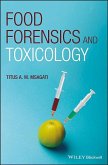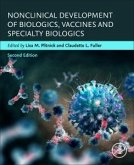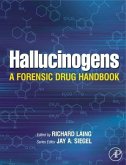Nutraceuticals
Efficacy, Safety and Toxicity
Herausgeber: Gupta, Ramesh C; Srivastava, Ajay; Lall, Rajiv
Nutraceuticals
Efficacy, Safety and Toxicity
Herausgeber: Gupta, Ramesh C; Srivastava, Ajay; Lall, Rajiv
- Gebundenes Buch
- Merkliste
- Auf die Merkliste
- Bewerten Bewerten
- Teilen
- Produkt teilen
- Produkterinnerung
- Produkterinnerung
Presents a completely revised and updated resource on the impact of nutraceuticals and various disease states such as diabetes and ophthalmic and dermal diseases Grants an overview of the current state-of-the-science of nutraceuticals, their use and applications, and known adverse effects Provides effective tools to evaluate the potential toxicity of any nutraceutical Includes details of regulatory issues as written by international experts
Andere Kunden interessierten sich auch für
![Listeria Listeria]() Chris BellListeria119,99 €
Chris BellListeria119,99 €![Plant Derived Bioactive Compounds in Human Health and Disease Plant Derived Bioactive Compounds in Human Health and Disease]() Plant Derived Bioactive Compounds in Human Health and Disease220,99 €
Plant Derived Bioactive Compounds in Human Health and Disease220,99 €![Food Forensics and Toxicology Food Forensics and Toxicology]() Titus A M MsagatiFood Forensics and Toxicology222,99 €
Titus A M MsagatiFood Forensics and Toxicology222,99 €![Neglected and Underutilized Crops Neglected and Underutilized Crops]() Neglected and Underutilized Crops146,99 €
Neglected and Underutilized Crops146,99 €![Nonclinical Development of Biologics, Vaccines and Specialty Biologics Nonclinical Development of Biologics, Vaccines and Specialty Biologics]() Nonclinical Development of Biologics, Vaccines and Specialty Biologics166,99 €
Nonclinical Development of Biologics, Vaccines and Specialty Biologics166,99 €![Hallucinogens Hallucinogens]() Richard Laing (ed.)Hallucinogens146,99 €
Richard Laing (ed.)Hallucinogens146,99 €![Nutraceuticals Inspiring the Contemporary Therapy for Lifestyle Diseases Nutraceuticals Inspiring the Contemporary Therapy for Lifestyle Diseases]() Nutraceuticals Inspiring the Contemporary Therapy for Lifestyle Diseases155,99 €
Nutraceuticals Inspiring the Contemporary Therapy for Lifestyle Diseases155,99 €-
-
-
Presents a completely revised and updated resource on the impact of nutraceuticals and various disease states such as diabetes and ophthalmic and dermal diseases Grants an overview of the current state-of-the-science of nutraceuticals, their use and applications, and known adverse effects Provides effective tools to evaluate the potential toxicity of any nutraceutical Includes details of regulatory issues as written by international experts
Hinweis: Dieser Artikel kann nur an eine deutsche Lieferadresse ausgeliefert werden.
Hinweis: Dieser Artikel kann nur an eine deutsche Lieferadresse ausgeliefert werden.
Produktdetails
- Produktdetails
- Verlag: Elsevier Science
- 2nd edition
- Seitenzahl: 1396
- Erscheinungstermin: 8. Februar 2021
- Englisch
- Abmessung: 282mm x 218mm x 56mm
- Gewicht: 2994g
- ISBN-13: 9780128210383
- ISBN-10: 0128210389
- Artikelnr.: 59885269
- Herstellerkennzeichnung
- Libri GmbH
- Europaallee 1
- 36244 Bad Hersfeld
- gpsr@libri.de
- Verlag: Elsevier Science
- 2nd edition
- Seitenzahl: 1396
- Erscheinungstermin: 8. Februar 2021
- Englisch
- Abmessung: 282mm x 218mm x 56mm
- Gewicht: 2994g
- ISBN-13: 9780128210383
- ISBN-10: 0128210389
- Artikelnr.: 59885269
- Herstellerkennzeichnung
- Libri GmbH
- Europaallee 1
- 36244 Bad Hersfeld
- gpsr@libri.de
Section I. Applications of nutraceuticals in common diseases and disorders
1. Nutraceuticals in central nervous system diseases: potential mechanisms
of neuroprotection
2. Prevention of neurodegenerative disorders by nutraceuticals
3. Cognitive effects of nutraceuticals
4. Nutraceuticals in anxiety and stress
5. Countering cardiovascular diseases with nutraceuticals
6. Nutraceuticals for diabetes and glucose balance
7. Role of nutraceuticals in respiratory and allied diseases
8. Nutraceuticals in hepatic diseases
9. Nutraceuticals in renal diseases
10. Nutraceuticals in gastrointestinal disorders
11. Nutraceuticals in reproductive and developmental disorders
12. Nutraceuticals in ophthalmic diseases
13. Nutraceuticals in dermal diseases
14. Nutraceuticals in arthritis
15. Nutraceuticals in sports activities and fatigue
16. Role of nutraceuticals as adaptogens
17. Nutraceuticals for weight loss
18. Nutraceuticals in cancer prevention
19. Application of "nano? nutraceuticals in medicine
Section II. Models and mechanisms in evaluation of nutraceuticals
20. The biology of nutrients: genetic and molecular principles
21. Genomic and proteomic mechanisms and models in toxicity and safety
evaluation of nutraceuticals
22. Transcriptomic profiling for safety and toxicity evaluation of
nutraceuticals
23. Target identification and polypharmacology of nutraceuticals
24. Systems pharmacology investigation of mechanism of action of
nutraceuticals
25. Noninvasive in vivo optical imaging models for safety and toxicity
testing
26. Flow cytometry and light-scattering techniques in evaluation of
nutraceuticals
27. Zebrafish as a model system to evaluate the safety and toxicity of
nutraceuticals
28. Caenorhabditis elegans: an elegant model organism for evaluating the
neuroprotective and neurotherapeutic potential of nutraceuticals
29. Alternative in vitro models for safety and toxicity evaluation of
nutraceuticals
30. Mitochondria as a target for safety and toxicity evaluation of
nutraceuticals
31. Oxidative stress and excitotoxicity: antioxidants from nutraceuticals
Section III. Common nutraceuticals
32. Caffeine: an evaluation of the safety database
33. Biological activities and potential nanotechnological delivery of
resveratrol
34. Melatonin: a safe nutraceutical and clinical agent
35. Standardized turmeric and curcumin
36. Curcuminoid-metal complexes for oxidative stress
37. Fenugreek: multiple health benefits
38. Cannabis sativa: an overview
39. Cannabidiol safety
40. St John's wort (Hypericum perforatum L)
41. Green tea
42. Green coffee beans
43. Quercetin
44. German chamomile
45. Isoflavones: toxicological aspects and efficacy
46. Propolis
47. Bee products as nutraceuticals to nutraceuticals for bees
48. Ginkgo biloba
49. Chinese ginseng
50. Ashwagandha: multiple health benefits
51. Astaxanthin: health benefits and toxicity
52. Thymoquinone
53. Glucosinolates
54. Organosulfur compounds as nutraceuticals
55. Arginine and citrulline as nutraceuticals: efficacy and safety in
diseases
56. Neem Extract
57. Spirulina
58. Garcinia cambogia
59. Vitamin E TPGS and its applications in nutraceuticals
60. Role of transferrin: an iron-binding protein in health and diseases
61. Glutamine supplementation: hope, hype, or stay tuned?
62. What to do with placenta after birth: is it a waste?
63. Chitin, chitosan, and their derivatives
Section IV. Prebiotics and probiotics
64. Prebiotics: safety and toxicity considerations
65. Probiotics: safety and toxicity considerations
66. Synbiotics: safety and toxicity considerations
Section V. Nutraceuticals in veterinary medicine
67. Nutraceuticals in animal health and diseases
Section VI. Toxicity and toxic interactions
68. Toxic contamination of nutraceuticals and food ingredients
69. Nutraceuticals and adverse outcome pathways
70. Interactions between nutraceuticals/nutrients and nutrients and
therapeutic drugs
71. Genotoxicity evaluation of nutraceuticals
Section VII. Regulatory aspects
72. The regulatory framework for nutraceuticals: North America
73. Evaluation and regulation of food supplements: European perspective
74. Regulatory guidelines for nutraceuticals in India: an overview
75. Regulatory aspects of nutraceuticals: Chinese perspective
76. Uses and regulation of nutraceuticals: Australia and New Zealand
77. Regulatory aspects of nutraceuticals: Japanese perspective
78. Nutraceuticals: the Turkish perspective
1. Nutraceuticals in central nervous system diseases: potential mechanisms
of neuroprotection
2. Prevention of neurodegenerative disorders by nutraceuticals
3. Cognitive effects of nutraceuticals
4. Nutraceuticals in anxiety and stress
5. Countering cardiovascular diseases with nutraceuticals
6. Nutraceuticals for diabetes and glucose balance
7. Role of nutraceuticals in respiratory and allied diseases
8. Nutraceuticals in hepatic diseases
9. Nutraceuticals in renal diseases
10. Nutraceuticals in gastrointestinal disorders
11. Nutraceuticals in reproductive and developmental disorders
12. Nutraceuticals in ophthalmic diseases
13. Nutraceuticals in dermal diseases
14. Nutraceuticals in arthritis
15. Nutraceuticals in sports activities and fatigue
16. Role of nutraceuticals as adaptogens
17. Nutraceuticals for weight loss
18. Nutraceuticals in cancer prevention
19. Application of "nano? nutraceuticals in medicine
Section II. Models and mechanisms in evaluation of nutraceuticals
20. The biology of nutrients: genetic and molecular principles
21. Genomic and proteomic mechanisms and models in toxicity and safety
evaluation of nutraceuticals
22. Transcriptomic profiling for safety and toxicity evaluation of
nutraceuticals
23. Target identification and polypharmacology of nutraceuticals
24. Systems pharmacology investigation of mechanism of action of
nutraceuticals
25. Noninvasive in vivo optical imaging models for safety and toxicity
testing
26. Flow cytometry and light-scattering techniques in evaluation of
nutraceuticals
27. Zebrafish as a model system to evaluate the safety and toxicity of
nutraceuticals
28. Caenorhabditis elegans: an elegant model organism for evaluating the
neuroprotective and neurotherapeutic potential of nutraceuticals
29. Alternative in vitro models for safety and toxicity evaluation of
nutraceuticals
30. Mitochondria as a target for safety and toxicity evaluation of
nutraceuticals
31. Oxidative stress and excitotoxicity: antioxidants from nutraceuticals
Section III. Common nutraceuticals
32. Caffeine: an evaluation of the safety database
33. Biological activities and potential nanotechnological delivery of
resveratrol
34. Melatonin: a safe nutraceutical and clinical agent
35. Standardized turmeric and curcumin
36. Curcuminoid-metal complexes for oxidative stress
37. Fenugreek: multiple health benefits
38. Cannabis sativa: an overview
39. Cannabidiol safety
40. St John's wort (Hypericum perforatum L)
41. Green tea
42. Green coffee beans
43. Quercetin
44. German chamomile
45. Isoflavones: toxicological aspects and efficacy
46. Propolis
47. Bee products as nutraceuticals to nutraceuticals for bees
48. Ginkgo biloba
49. Chinese ginseng
50. Ashwagandha: multiple health benefits
51. Astaxanthin: health benefits and toxicity
52. Thymoquinone
53. Glucosinolates
54. Organosulfur compounds as nutraceuticals
55. Arginine and citrulline as nutraceuticals: efficacy and safety in
diseases
56. Neem Extract
57. Spirulina
58. Garcinia cambogia
59. Vitamin E TPGS and its applications in nutraceuticals
60. Role of transferrin: an iron-binding protein in health and diseases
61. Glutamine supplementation: hope, hype, or stay tuned?
62. What to do with placenta after birth: is it a waste?
63. Chitin, chitosan, and their derivatives
Section IV. Prebiotics and probiotics
64. Prebiotics: safety and toxicity considerations
65. Probiotics: safety and toxicity considerations
66. Synbiotics: safety and toxicity considerations
Section V. Nutraceuticals in veterinary medicine
67. Nutraceuticals in animal health and diseases
Section VI. Toxicity and toxic interactions
68. Toxic contamination of nutraceuticals and food ingredients
69. Nutraceuticals and adverse outcome pathways
70. Interactions between nutraceuticals/nutrients and nutrients and
therapeutic drugs
71. Genotoxicity evaluation of nutraceuticals
Section VII. Regulatory aspects
72. The regulatory framework for nutraceuticals: North America
73. Evaluation and regulation of food supplements: European perspective
74. Regulatory guidelines for nutraceuticals in India: an overview
75. Regulatory aspects of nutraceuticals: Chinese perspective
76. Uses and regulation of nutraceuticals: Australia and New Zealand
77. Regulatory aspects of nutraceuticals: Japanese perspective
78. Nutraceuticals: the Turkish perspective
Section I. Applications of nutraceuticals in common diseases and disorders
1. Nutraceuticals in central nervous system diseases: potential mechanisms
of neuroprotection
2. Prevention of neurodegenerative disorders by nutraceuticals
3. Cognitive effects of nutraceuticals
4. Nutraceuticals in anxiety and stress
5. Countering cardiovascular diseases with nutraceuticals
6. Nutraceuticals for diabetes and glucose balance
7. Role of nutraceuticals in respiratory and allied diseases
8. Nutraceuticals in hepatic diseases
9. Nutraceuticals in renal diseases
10. Nutraceuticals in gastrointestinal disorders
11. Nutraceuticals in reproductive and developmental disorders
12. Nutraceuticals in ophthalmic diseases
13. Nutraceuticals in dermal diseases
14. Nutraceuticals in arthritis
15. Nutraceuticals in sports activities and fatigue
16. Role of nutraceuticals as adaptogens
17. Nutraceuticals for weight loss
18. Nutraceuticals in cancer prevention
19. Application of "nano? nutraceuticals in medicine
Section II. Models and mechanisms in evaluation of nutraceuticals
20. The biology of nutrients: genetic and molecular principles
21. Genomic and proteomic mechanisms and models in toxicity and safety
evaluation of nutraceuticals
22. Transcriptomic profiling for safety and toxicity evaluation of
nutraceuticals
23. Target identification and polypharmacology of nutraceuticals
24. Systems pharmacology investigation of mechanism of action of
nutraceuticals
25. Noninvasive in vivo optical imaging models for safety and toxicity
testing
26. Flow cytometry and light-scattering techniques in evaluation of
nutraceuticals
27. Zebrafish as a model system to evaluate the safety and toxicity of
nutraceuticals
28. Caenorhabditis elegans: an elegant model organism for evaluating the
neuroprotective and neurotherapeutic potential of nutraceuticals
29. Alternative in vitro models for safety and toxicity evaluation of
nutraceuticals
30. Mitochondria as a target for safety and toxicity evaluation of
nutraceuticals
31. Oxidative stress and excitotoxicity: antioxidants from nutraceuticals
Section III. Common nutraceuticals
32. Caffeine: an evaluation of the safety database
33. Biological activities and potential nanotechnological delivery of
resveratrol
34. Melatonin: a safe nutraceutical and clinical agent
35. Standardized turmeric and curcumin
36. Curcuminoid-metal complexes for oxidative stress
37. Fenugreek: multiple health benefits
38. Cannabis sativa: an overview
39. Cannabidiol safety
40. St John's wort (Hypericum perforatum L)
41. Green tea
42. Green coffee beans
43. Quercetin
44. German chamomile
45. Isoflavones: toxicological aspects and efficacy
46. Propolis
47. Bee products as nutraceuticals to nutraceuticals for bees
48. Ginkgo biloba
49. Chinese ginseng
50. Ashwagandha: multiple health benefits
51. Astaxanthin: health benefits and toxicity
52. Thymoquinone
53. Glucosinolates
54. Organosulfur compounds as nutraceuticals
55. Arginine and citrulline as nutraceuticals: efficacy and safety in
diseases
56. Neem Extract
57. Spirulina
58. Garcinia cambogia
59. Vitamin E TPGS and its applications in nutraceuticals
60. Role of transferrin: an iron-binding protein in health and diseases
61. Glutamine supplementation: hope, hype, or stay tuned?
62. What to do with placenta after birth: is it a waste?
63. Chitin, chitosan, and their derivatives
Section IV. Prebiotics and probiotics
64. Prebiotics: safety and toxicity considerations
65. Probiotics: safety and toxicity considerations
66. Synbiotics: safety and toxicity considerations
Section V. Nutraceuticals in veterinary medicine
67. Nutraceuticals in animal health and diseases
Section VI. Toxicity and toxic interactions
68. Toxic contamination of nutraceuticals and food ingredients
69. Nutraceuticals and adverse outcome pathways
70. Interactions between nutraceuticals/nutrients and nutrients and
therapeutic drugs
71. Genotoxicity evaluation of nutraceuticals
Section VII. Regulatory aspects
72. The regulatory framework for nutraceuticals: North America
73. Evaluation and regulation of food supplements: European perspective
74. Regulatory guidelines for nutraceuticals in India: an overview
75. Regulatory aspects of nutraceuticals: Chinese perspective
76. Uses and regulation of nutraceuticals: Australia and New Zealand
77. Regulatory aspects of nutraceuticals: Japanese perspective
78. Nutraceuticals: the Turkish perspective
1. Nutraceuticals in central nervous system diseases: potential mechanisms
of neuroprotection
2. Prevention of neurodegenerative disorders by nutraceuticals
3. Cognitive effects of nutraceuticals
4. Nutraceuticals in anxiety and stress
5. Countering cardiovascular diseases with nutraceuticals
6. Nutraceuticals for diabetes and glucose balance
7. Role of nutraceuticals in respiratory and allied diseases
8. Nutraceuticals in hepatic diseases
9. Nutraceuticals in renal diseases
10. Nutraceuticals in gastrointestinal disorders
11. Nutraceuticals in reproductive and developmental disorders
12. Nutraceuticals in ophthalmic diseases
13. Nutraceuticals in dermal diseases
14. Nutraceuticals in arthritis
15. Nutraceuticals in sports activities and fatigue
16. Role of nutraceuticals as adaptogens
17. Nutraceuticals for weight loss
18. Nutraceuticals in cancer prevention
19. Application of "nano? nutraceuticals in medicine
Section II. Models and mechanisms in evaluation of nutraceuticals
20. The biology of nutrients: genetic and molecular principles
21. Genomic and proteomic mechanisms and models in toxicity and safety
evaluation of nutraceuticals
22. Transcriptomic profiling for safety and toxicity evaluation of
nutraceuticals
23. Target identification and polypharmacology of nutraceuticals
24. Systems pharmacology investigation of mechanism of action of
nutraceuticals
25. Noninvasive in vivo optical imaging models for safety and toxicity
testing
26. Flow cytometry and light-scattering techniques in evaluation of
nutraceuticals
27. Zebrafish as a model system to evaluate the safety and toxicity of
nutraceuticals
28. Caenorhabditis elegans: an elegant model organism for evaluating the
neuroprotective and neurotherapeutic potential of nutraceuticals
29. Alternative in vitro models for safety and toxicity evaluation of
nutraceuticals
30. Mitochondria as a target for safety and toxicity evaluation of
nutraceuticals
31. Oxidative stress and excitotoxicity: antioxidants from nutraceuticals
Section III. Common nutraceuticals
32. Caffeine: an evaluation of the safety database
33. Biological activities and potential nanotechnological delivery of
resveratrol
34. Melatonin: a safe nutraceutical and clinical agent
35. Standardized turmeric and curcumin
36. Curcuminoid-metal complexes for oxidative stress
37. Fenugreek: multiple health benefits
38. Cannabis sativa: an overview
39. Cannabidiol safety
40. St John's wort (Hypericum perforatum L)
41. Green tea
42. Green coffee beans
43. Quercetin
44. German chamomile
45. Isoflavones: toxicological aspects and efficacy
46. Propolis
47. Bee products as nutraceuticals to nutraceuticals for bees
48. Ginkgo biloba
49. Chinese ginseng
50. Ashwagandha: multiple health benefits
51. Astaxanthin: health benefits and toxicity
52. Thymoquinone
53. Glucosinolates
54. Organosulfur compounds as nutraceuticals
55. Arginine and citrulline as nutraceuticals: efficacy and safety in
diseases
56. Neem Extract
57. Spirulina
58. Garcinia cambogia
59. Vitamin E TPGS and its applications in nutraceuticals
60. Role of transferrin: an iron-binding protein in health and diseases
61. Glutamine supplementation: hope, hype, or stay tuned?
62. What to do with placenta after birth: is it a waste?
63. Chitin, chitosan, and their derivatives
Section IV. Prebiotics and probiotics
64. Prebiotics: safety and toxicity considerations
65. Probiotics: safety and toxicity considerations
66. Synbiotics: safety and toxicity considerations
Section V. Nutraceuticals in veterinary medicine
67. Nutraceuticals in animal health and diseases
Section VI. Toxicity and toxic interactions
68. Toxic contamination of nutraceuticals and food ingredients
69. Nutraceuticals and adverse outcome pathways
70. Interactions between nutraceuticals/nutrients and nutrients and
therapeutic drugs
71. Genotoxicity evaluation of nutraceuticals
Section VII. Regulatory aspects
72. The regulatory framework for nutraceuticals: North America
73. Evaluation and regulation of food supplements: European perspective
74. Regulatory guidelines for nutraceuticals in India: an overview
75. Regulatory aspects of nutraceuticals: Chinese perspective
76. Uses and regulation of nutraceuticals: Australia and New Zealand
77. Regulatory aspects of nutraceuticals: Japanese perspective
78. Nutraceuticals: the Turkish perspective

